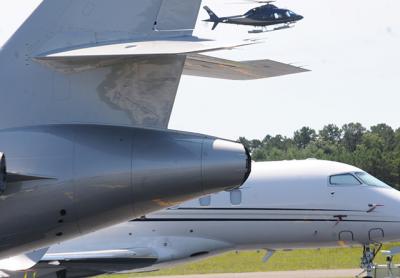Town Eyes Ways to Quell Noise

East Hampton Town could have an answer in June as to whether the legality of three laws designed to cut down on aircraft noise over the community by restricting hours and access to the airport will be assessed by the highest court in the land.
The laws were struck down by an appeals court last fall.
East Hampton Town Attorney Michael Sendlenski told the town board on Tuesday that, following the submission of briefs regarding the case over the last week, the United States Supreme Court has scheduled a conference on Friday, April 28, to discuss the town’s petition and the briefs. An order as to “where our petition will go,” said Mr. Sendlenski, would be expected in the ensuing days.
In the meantime, Mr. Sendlenski said, the town is working with state and federal elected officials on legislative initiatives that could help address the airport noise problem, and is looking at what would be needed to complete the Federal Aviation Administration’s comprehensive analysis and application process, called a Part 161 procedure, to gain approval for locally imposed airport restrictions. The court decision against the town’s airport regulations found that they could not be enacted without complying with that F.A.A. process.
While the ruling against East Hampton’s three 2015 airport restriction laws — an overnight curfew on landings and takeoffs, an extended-hour curfew for noisy planes, and a once-a-week maximum on visits by noisy planes, all seasonal — was the result of one lawsuit by aviation interests, another lawsuit regarding the regulations, by the Friends of the East Hampton Airport, is pending but being held in abeyance pending the Supreme Court’s decision on hearing East Hampton’s case, Mr. Sendlenski said.
Initial court rulings let the two curfews stand. They remained in effect from the summer of 2015 until they were ruled out last fall. The one-time-per week trip limit was never allowed to be enacted.
East Hampton is represented in its Supreme Court case, filed at the start of this year, by Kathleen Sullivan and David Cooper of Quinn Emanuel Urquhart and Sullivan.
Earlier this month, the City of New York, the Town of Southold, and the International Municipal Lawyers Association, along with the local Committee to Stop Airport Expansion, filed “friend of the court” briefs in support of the town.
At a town board meeting on Tuesday, consultants from Harris, Miller, Miller, and Hansen, a firm hired by the town to collect and collate data on airport noise — which was used as the legal underpinning for the three adopted airport noise restrictions — presented a review of airport operations and complaints spanning the period of June 30 through Sept. 30, 2016.
While overall traffic at the airport remained essentially the same in 2016 as during the same period in 2015, the number of complaints about aircraft noise rose by 27 percent, with a total of 24,309 last year, up from 19,099 in 2015.
The use of a second complaint system in addition to Plane Noise, the system the town has had in place, largely accounts for the spike, the consultants said. While Plane Noise logged in 9,754 complaints, through its phone hotline, online reporting system, and email tally, the addition of another system, called Air Noise Report, created a new way for people to lodge an objection to a noisy plane flying overhead.
The Air Noise Report system, created by a resident of western Long Island, provides access to a map that shows in real time aircraft flying overhead, and tracks information about them. Additional antennas for the system have been going up on the East End, although coverage is still incomplete. However, complaints lodged with Air Noise Report by East End residents about planes using East Hampton Airport accounted for 41 percent of the total noise complaints last year, or 9,877 individual complaints.
Both systems provide tools for the town to track the problem of aircraft noise, the consultants said, though each has its own shortfalls. Councilwoman Kathee Burke-Gonzalez, the airport liaison, said she hopes East Hampton officials can work with the proprietors of each system to address shortcomings and increase their effectiveness here.
Complaints about seaplanes increased last year by 71 percent, or 1,087 complaints. Seaplane operations, or takeoffs and landings, went up from a total of 1,882 in 2015 to 2,155 in 2016.
The airport overnight curfews did “exactly what we wanted them to do,” Mr. Baldwin said, with compliance by pilots, and the operation of aircraft that fall into a “noisy” category shifting out of the restricted nighttime hours into unrestricted daytime hours.
Flights in or out during the nighttime curfew hours “remained at essentially zero,” according to the consultants’ presentation. But, “at 5 o’clock in the morning, it only takes one,” commented Tom MacNiven, a Wainscott resident who has been active in airport matters, including serving on an airport advisory committee.
The consultants’ report, which will be posted on the town’s website, also provides an analysis of airport noise complaint data based on geographic location, aircraft type, and inbound and outbound flight routes used by members of the Eastern Region Helicopter Council on a voluntary basis to cooperate with the town on noise abatement.
Following the airport consultants’ report, Jeffery Smith, the head of that organization, provided an overview of that effort, which had been presented at a March “fly neighborly” meeting of the helicopter council.
